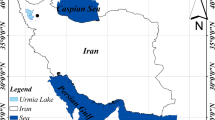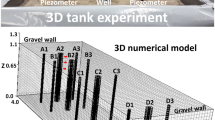Abstract
Evaporation, as the main source of water loss from closed lakes, makes a significant contribution to the water balance equation of the lake and can lead to changes in the chemical composition thereof. The objective of the study was to develop an equation for estimation of evaporation from the water surface with different depths and concentrations. To that end, 48 barrels were used to model evaporation at 6 different depths and 8 different concentrations of salinity. The experiments have been conducted in the same meteorological condition for all the barrels near the Urmia Lake. Data were collected in March 1, 2019, to Aug 31, 2019. Different equations fitted to data for each concentrations of salinity separately with different depths, and the equations with the least errors were selected. A model was then developed for the estimation of evaporation, considering the effect of salinity and depth, and the results were compared with daily measurements. The results were evaluated using the root mean square error (RMSE), correlation coefficient (CC), and Nash-Sutcliffe efficiency coefficient (NS). The results indicated that evaporation (Horizontal row) from water surface with high concentrations of salinity to low concentrations of salinity in different depths had an incremental trend. However, it can be seen in the vertical row that evaporation increased from low depth to high depth, and then decreased at a certain depth (120 cm) while the maximum evaporation rate belonged to 90-cm barrels for each concentration of salinity (in the vertical and horizontal row). At the end, the comparison of evaporation computed from the model and measured data showed that the model estimated evaporation at different depths and concentrations of salinity satisfactorily.








Similar content being viewed by others
References
Aghelpour, P., Mohammadi, B., & Biazar, S. M. (2019). Long-term monthly average temperature forecasting in some climate types of Iran, using the models SARIMA, SVR, and SVR-FA. Theoretical and Applied Climatology, 138(3–4), 1471–1480.
AL-Khlaifat, A. L. (2008). Dead Sea rate of evaporation. American Journal of Applied Sciences, 5(8), 934–942.
Allen, R. G., Pereira, L. S., Raes, D., & Smith, M. (1998). Crop evapotranspiration-guidelines for computing crop water requirements-FAO Irrigation and drainage paper 56. Fao, Rome, 300(9), D05109.
Ashrafzadeh, A., Ghorbani, M. A., Biazar, S. M., & Yaseen, Z. M. (2019). Evaporation process modelling over northern Iran: application of an integrative data-intelligence model with the krill herd optimization algorithm. Hydrological Sciences Journal, 64(15), 1843–1856.
Ashrafzadeh, A., Kişi, O., Aghelpour, P., Biazar, S. M., & Masouleh, M. A. (2020). Comparative study of time series models, support vector machines, and GMDH in forecasting long-term evapotranspiration rates in northern Iran. Journal of Irrigation and Drainage Engineering, 146(6), 04020010.
Ashrafzadeh, A., Malik, A., Jothiprakash, V., Ghorbani, M. A., & Biazar, S. M. (2018). Estimation of daily pan evaporation using neural networks and meta-heuristic approaches. ISH Journal of Hydraulic Engineering, 1–9.
Asmar, B. N., & Ergenzinger, P. (1999). Estimation of evaporation from the Dead Sea. Hydrological Processes, 13(17), 2743–2750.
Biazar, S. M., Dinpashoh, Y., & Singh, V. P. (2019). Sensitivity analysis of the reference crop evapotranspiration in a humid region. Environmental Science and Pollution Research, 26(31), 32517–32544.
Biazar, S. M., & Ferdosi, F. B. (2020a). An investigation on spatial and temporal trends in frost indices in Northern Iran. Theoretical and Applied Climatology. https://doi.org/10.1007/s00704-020-03248-7.
Biazar, S. M., Rahmani, V., Isazadeh, M., Kisi, O., & Dinpashoh, Y. (2020). New input selection procedure for machine learning methods in estimating daily global solar radiation. Arabian Journal of Geosciences, 13, 431.
Biazar, S. M., Fard, A. F., Singh, V. P., Dinpashoh, Y., & Majnooni-Heris, A. (2020c). Estimation of Evaporation from Saline-Water with More Efficient Input Variables. Pure and Applied Geophysics, 1–21.
Deo, R. C., Ghorbani, M. A., Samadianfard, S., Maraseni, T., Bilgili, M., & Biazar, M. (2018). Multi-layer perceptron hybrid model integrated with the firefly optimizer algorithm for windspeed prediction of target site using a limited set of neighboring reference station data. Renewable Energy, 116, 309–323.
Dinpashoh, Y., Singh, V. P., Biazar, S. M., & Kavehkar, S. (2019). Impact of climate change on streamflow timing (case study: Guilan Province). Theoretical and Applied Climatology, 138(1–2), 65–76.
El-Dessouky, H. T., Ettouney, H. M., Alatiqi, I. M., & Al-Shamari, M. A. (2002). Evaporation rates from fresh and saline water in moving air. Industrial & Engineering Chemistry Research, 41(3), 642–650.
El-Sebaii, A. A., Ramadan, M. R. I., Aboul-Enein, S., & Khallaf, A. M. (2011). History of the solar ponds: a review study. Renewable and Sustainable Energy Reviews, 15(6), 3319–3325.
Estévez, J., Gavilán, P., & Berengena, J. (2009). Sensitivity analysis of a Penman–Monteith type equation to estimate reference evapotranspiration in southern Spain. Hydrological Processes: An International Journal, 23(23), 3342–3353.
Gianniou, S. K., & Antonopoulos, V. Z. (2007). Evaporation and energy budget in Lake Vegoritis, Greece. Journal of Hydrology, 345(3–4), 212–223.
Giestas, M., Pina, H., & Joyce, A. (1996). The influence of radiation absorption on solar pond stability. International Journal of Heat and Mass Transfer, 39(18), 3873–3885.
Guo, Y., Zhang, Y., Ma, N., Xu, J., & Zhang, T. (2019). Long-term changes in evaporation over Siling Co Lake on the Tibetan Plateau and its impact on recent rapid lake expansion. Atmospheric Research, 216, 141–150.
Hamdani, I., Assouline, S., Tanny, J., Lensky, I. M., Gertman, I., Mor, Z., & Lensky, N. G. (2018). Seasonal and diurnal evaporation from a deep hypersaline lake: The Dead Sea as a case study. Journal of Hydrology, 562, 155–167.
Hull, J., Nielsen, C. E., & Golding, P. (1989). Salinity gradient solar ponds. Boca Raton, FL: CRC Press.
Isazadeh, M., Biazar, S. M., & Ashrafzadeh, A. (2017). Support vector machines and feed-forward neural networks for spatial modeling of groundwater qualitative parameters. Environmental Earth Sciences, 76(17), 610.
Khaledian, M. R., Isazadeh, M., Biazar, S. M., & Pham, Q. B. (2020). Simulating Caspian Sea surface water level by artificial neural network and support vector machine models. Acta Geophysica, 1–11.
Kisi, O., Shiri, J., Karimi, S., Shamshirband, S., Motamedi, S., Petković, D., & Hashim, R. (2015). A survey of water level fluctuation predicting in Urmia Lake using support vector machine with firefly algorithm. Applied Mathematics and Computation, 270, 731–743.
Kokya, B. A., & Kokya, T. A. (2008). Proposing a formula for evaporation measurement from salt water resources. Hydrological Processes: An International Journal, 22(12), 2005–2012.
Kurt, H., Halici, F., & Binark, A. (2000). Solar pond conception: Experimental and theoretical studies. Energ. Convers. Manage., 41(9), 939–951.
Lee, C. H. (1927). Discussion of evaporation on reclamation projects. American Society of Civil Engineers Transactions, 90, 340–343.
Lide, D. R. (Ed). (2005) CRC handbook of chemistry and physics 86th ed. CRC Publishing: Boca Raton, FL pp 8.
Lin, S. T., & Sandler, S. I. (1999). Prediction of octanol− water partition coefficients using a group contribution solvation model. Industrial & Engineering Chemistry Research, 38(10), 4081–4091.
Ma, N., Szilagyi, J., Niu, G. Y., Zhang, Y., Zhang, T., Wang, B., & Wu, Y. (2016). Evaporation variability of Nam Co Lake in the Tibetan Plateau and its role in recent rapid lake expansion. Journal of Hydrology, 537, 27–35.
Mansour, R. B., Nguyen, C. T., & Galanis, N. (2006). Transient heat and mass transfer and long-term stability of a salt-gradient solar pond. Mechanics research communications, 33(2), 233–249.
Mor, Z., Assouline, S., Tanny, J., Lensky, I. M., & Lensky, N. G. (2018). Effect of water surface salinity on evaporation: The case of a diluted buoyant plume over the Dead Sea. Water Resources Research, 54(3), 1460–1475.
Naganna, S. R., Deka, P. C., Ghorbani, M. A., Biazar, S. M., Al-Ansari, N., & Yaseen, Z. M. (2019). Dew point temperature estimation: application of artificial intelligence model integrated with nature-inspired optimization algorithms. Water, 11(4), 742.
Nash, J. E., & Sutcliffe, J. V. (1970). River flow forecasting through conceptual models part I—A discussion of principles. Journal of hydrology, 10(3), 282–290.
Nozari, H., & Azadi, S. (2019). Experimental evaluation of artificial neural network for predicting drainage water and groundwater salinity at various drain depths and spacing. Neural Computing and Applications, 31(4), 1227–1236.
Rabl, A., & Nielsen, C. E. (1975). Solar ponds for space heating. Solar Energy, 17(1), 1–12.
Ruskowitz, J. A., Suárez, F., Tyler, S. W., & Childress, A. E. (2014). Evaporation suppression and solar energy collection in a salt-gradient solar pond. Solar Energy, 99, 36–46.
Shiri, J., Shamshirband, S., Kisi, O., Karimi, S., Bateni, S. M., Nezhad, S. H. H., & Hashemi, A. (2016). Prediction of water-level in the Urmia Lake using the extreme learning machine approach. Water Resources Management, 30(14), 5217–5229.
Suárez, F., Tyler, S. W., & Childress, A. E. (2010). A fully coupled, transient double-diffusive convective model for salt-gradient solar ponds. International Journal of Heat and Mass Transfer, 53(9-10), 1718–1730.
Vaheddoost, B., & Kocak, K. (2019). Temporal dynamics of monthly evaporation in Lake Urmia. Theoretical and Applied Climatology, 137(3-4), 2451–2462.
Wang, W., Lee, X., Xiao, W., Liu, S., Schultz, N., Wang, Y., & Zhao, L. (2018). Global lake evaporation accelerated by changes in surface energy allocation in a warmer climate. Nature Geoscience, 11(6), 410–414.
Wurtsbaugh, W. A., Miller, C., Null, S. E., DeRose, R. J., Wilcock, P., Hahnenberger, M., Howe, F., & Moore, J. (2017). Decline of the world's saline lakes. Nature Geoscience, 10(11), 816–821.
Young, A. A. (1947). Some recent evaporation investigations. Transactions American Geophysical Union, 28(2), 279–284.
Acknowledgements
The authors wish to thank Distinguished Professor John S. Selker (Oregon State University); Professor Reza Delirhasannia (University of Tabriz), Mr. Mohammad Isazadeh and Babak Mohammadpour for help us to complete this study.
Author information
Authors and Affiliations
Corresponding author
Additional information
Publisher’s note
Springer Nature remains neutral with regard to jurisdictional claims in published maps and institutional affiliations.
Rights and permissions
About this article
Cite this article
Biazar, S.M., Fard, A.F., Singh, V.P. et al. Estimation of evaporation from saline water. Environ Monit Assess 192, 694 (2020). https://doi.org/10.1007/s10661-020-08634-2
Received:
Accepted:
Published:
DOI: https://doi.org/10.1007/s10661-020-08634-2




